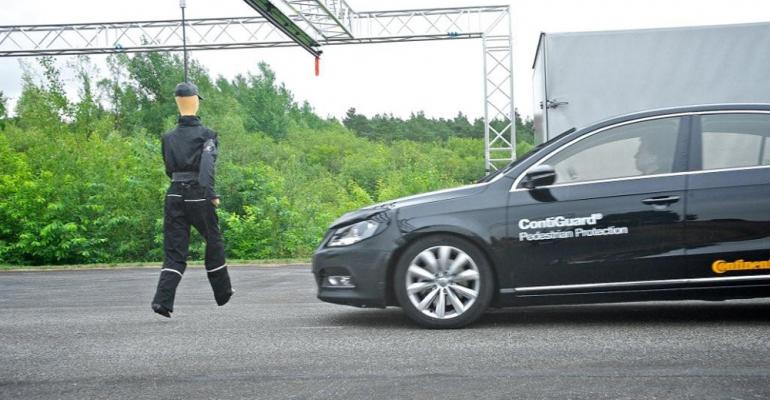ALZENAU, Germany – Continental already operates four automotive electronics plants in Mexico and is adding a fifth to produce short-range radar sensors to enhance vehicle and pedestrian safety beginning in 2014, an executive says at a media event here.
Short-range radar (24 GHz) is merely one piece in the German supplier’s product portfolio dedicated to Advanced Driver Assistance Systems, an emerging suite of technologies that includes cameras, radar and infrared lidar sensing that enables adaptive cruise control, pedestrian protection, forward collision warning, blind-spot detection, lane-change assist and autonomous emergency braking (AEB).
The location of the new plant in Mexico will be decided in coming weeks, and it is possible the facility will be co-located at one of the supplier’s current electronics plants in Cuautla, Guadalajara, Nogales or Tlaquepaque, Executive Vice President Friedrich Angerbauer tells WardsAuto.
At least five auto makers will source short-range radar sensors from the facility, and volume will quickly surpass 1 million units annually, says Angerbauer, who leads the ADAS business unit for Continental’s Chassis & Safety division.
The supplier’s sole source for the sensors is a factory in Ingolstadt, Germany, currently running at full capacity. The Ingolstadt facility launched the second-generation short-range radar sensor within the past year and is ramping up output. The new Mexican plant will produce the second-generation sensor, he says.
Continental is investing heavily in these systems because auto makers and governments want to eliminate traffic fatalities, and research is finding many of the active-safety technologies effective in reducing or avoiding collisions.
BASt, the German Federal Highway Research Institute, says 70% of all serious accidents potentially could be avoided by driver-assistance systems.
Continental claims the No.1 market position in this ADAS segment, which is expected to expand 40% within five years. The European New Car Assessment Program, which will roll out revised crash rating standards by 2016, is driving much of the growth.
Looking further into the future, the ultimate success or failure of fully autonomous vehicles will hinge on the reliability and performance of these systems.
But even before vehicles can drive themselves, significant research is focusing on systems currently in limited production. Euro NCAP finds premium brands such as Volvo, Infiniti and Mercedes have the best levels of standard AEB fitment, while Jaguar, Range Rover, Audi and Lexus offer it as optional.
AEB helps avoid crashes or mitigates their severity by using forward-looking radar, lidar or video systems to scan the road ahead, warn the driver and apply the brakes independently if the driver does not respond quickly enough.
The technology is not restricted to high-end vehicles. In Europe, the Mazda CX-5, Ford Focus and Honda Civic offer the systems as standard or optional, but not in the U.S. The VW Up! small car, not yet available in the U.S., also makes emergency braking available in Europe.
Real-world performance data from Euro NCAP suggests AEB systems can reduce accidents up to 27%, and yet the device is unavailable on 79% of new cars sold in Europe.
Continental claims to have been first to market with several advanced safety systems, including radar-based ACC and blind-spot detection.
In 2008, Continental began supplying short-range lidar as standard for Volvo’s emergency brake-assist system, intended to prevent low-speed accidents in city driving. European research shows 75% of crashes occur at vehicle speeds less than 20 mph (32 km/h).
Insurance companies endorse AEB because it has been proven to reduce claims.
U.K.-based Thatcham Research, which is funded by British insurance companies and conducts crash tests as part of Euro NCAP, predicts the number of personal-injury and damage claims will fall by 800,000 by 2018 if AEB continues a steady rollout in new vehicles.
“Real-world data suggests AEB is working,” Matthew Avery, head of research at Thatcham, says in a keynote presentation at the Continental event here.
In an awkward moment, in a room full of Continental executives and media, Avery says another technology from the supplier, lane-departure warning, is not helping to reduce accidents. As a result, customers who buy vehicles with the technology are not getting insurance discounts, he says.
But U.K. customers who purchase Volvos with AEB are eligible for insurance discounts of up to 15%, Avery adds. He also praises the new camera-based EyeSight AEB system appearing on the Subaru Outback and says buyers can receive insurance discounts of up to 24%.
Subaru developed the EyeSight system internally, with advanced stereo cameras placed on either side of the rear-view mirror behind the windshield.
Continental says it also has developed a stereo camera system for AEB functionality and that production will begin by year’s end.





